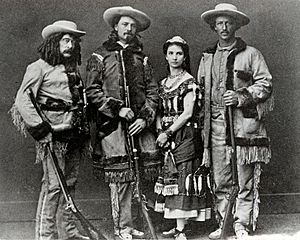Texas Jack Omohundro facts for kids
Quick facts for kids
Texas Jack Omohundro
|
|
|---|---|

Omohundro in 1872
|
|
| Born |
John Baker Omohundro
July 27, 1846 |
| Died | June 28, 1880 (aged 33) |
| Occupation | |
| Spouse(s) |
Giuseppina Morlacchi
(m. 1873) |
| Signature | |
 |
|
John Baker Omohundro (born July 27, 1846 – died June 28, 1880) was an American cowboy, scout, and actor. He was better known by his nickname, "Texas Jack".
Texas Jack was born in Virginia. He was a scout during the American Civil War and later for the US Army. He became famous for his exciting performances in Wild West shows across the country. Many dime novels were written about his adventures.
Contents
Early Life and War Service
John Omohundro was born on July 27, 1846, in Fluvanna County, Virginia. His family lived on a farm called Pleasure Hill. From a young age, he was very good at hunting and fishing.
When the American Civil War began, John tried to join the Confederate Army. He was too young at first. He worked as a messenger for the Virginia Militia. People called him the "Boy Scout of the Confederacy" because he was so young and knew the area well.
In 1864, at age 17, he joined the 5th Virginia Cavalry. He became a scout for General J. E. B. Stuart. He delivered important messages during battles. After being wounded, he returned to scouting for other generals until the war ended.
Adventures as a Cowboy and Hunter
After the Civil War, John Omohundro moved to Texas when he was 19. He became a cowboy on the Taylor Ranch. He helped drive cattle on the famous Chisholm Trail. People started calling him "Texas Jack" after one cattle drive.
In 1869, Texas Jack moved to Fort Hays, Kansas. There, he met famous figures like Wild Bill Hickok. He also became friends with William F. "Buffalo Bill" Cody. Texas Jack then worked as a scout for the US Army during the American Indian Wars. He even captured his famous white horse from a Native American chief.
Texas Jack also led many hunting trips for important people. In 1872, he and Buffalo Bill guided Grand Duke Alexei Alexandrovich of Russia on a royal hunt. Other famous military leaders like General Philip Sheridan were also on this trip. Later, in 1874, Texas Jack guided the Earl of Dunraven through Yellowstone National Park.
Becoming an Actor
In December 1872, Texas Jack and Buffalo Bill started the very first Wild West shows. Their first show was called Scouts of the Prairie. It opened in Chicago and was written by Ned Buntline. Texas Jack was praised for his acting. He was the first person to perform a rope trick on an American stage.
The show also featured Giuseppina Morlacchi, a talented dancer from Italy. Texas Jack and Giuseppina fell in love. They got married on August 31, 1873, in Rochester, New York.
Later, in 1873, Wild Bill Hickok joined the show for a new play. However, Hickok did not enjoy acting. He sometimes hid behind the scenery. Once, he even shot a spotlight! He left the group after a few months.
In 1877, Texas Jack started his own acting group called the Texas Jack Combination. His wife, Giuseppina, was part of the group. They performed plays like Texas Jack in the Black Hills. This play was very popular and received great reviews.
Texas Jack in Books
During the late 1800s, dime novels became very popular. These were cheap books that told exciting stories about the American frontier. Texas Jack became a popular hero in these stories.
One of the first novels about him was Texas Jack; or The White King of the Pawnees. It was written by Ned Buntline in 1872. Texas Jack's picture often appeared on the covers of these books. Many of these stories were written by a writer named Prentiss Ingraham. Texas Jack himself wrote one dime novel called Ned Wylde, the Boy Scout.
Later, in Germany, a series of dime novels about "Texas Jack, the Great Scout" became very popular. These stories were translated into many languages. They told fictional adventures of a scout and cowboy named Jack Hawkins.
In 1966, a British comic book called "Lion" also featured a series about Omohundro. These comics were later translated into Spanish.
Later Life and Legacy
Texas Jack and Giuseppina settled down in Massachusetts. They had a home in Lowell and a small farm. In 1880, they traveled to Leadville, Colorado, a silver-mining town.
Sadly, Texas Jack caught a cold that turned into pneumonia. He died a few weeks later. His funeral was well-attended, and he received full military honors. He was buried in Evergreen Cemetery in Leadville. Giuseppina returned home and never performed again.
Over time, Texas Jack's grave became worn. A group of comedians helped raise money to fix it. In 1908, William F. Cody visited the cemetery. He ordered a new granite grave marker for his old friend.
In 1980, the Texas Jack Association was created. Their goal is to keep Texas Jack's memory alive. In 1994, Texas Jack Omohundro was honored in the National Cowboy & Western Heritage Museum. He was inducted into the Hall of Great Western Performers.




